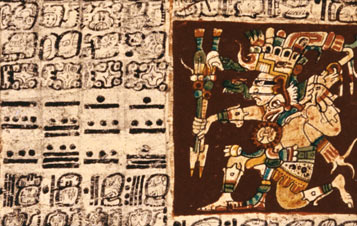Time Line of Decipherment

1832
Counting
Actual decipherment began with an eccentric European genius named
Constantine Rafinesque, who boasted of having dabbled in more than a
dozen professions, from archeology to zoology. His insatiable thirst
for knowledge had led Rafinesque to a reproduction of just five
pages of the Dresden Codex, from which he was able to crack the
Maya's system of counting. In 1832, Rafinesque declared in his
newsletter, the Atlantic Journal and Friend of Knowledge,
that the dots and bars seen in Maya glyphs (like these above, from
the Dresden Codex) represented simple numbers—a dot equaled
one and a bar five. Later findings proved him right and also
revealed that the Maya even had a symbol for zero, which appeared on
Mesoamerican carvings as early as 36 B.C. (Zero didn't appear in
Western Europe until the 12th century.)